A perennial plant native to the Northern Hemisphere, Yarrow benefits are many, so many in fact that the more we researched, the more we discovered. In addition to the many medicinal benefits, there are also many practical uses of yarrow that we’ll get into in this article.
Common Yarrow, Achillea millefolium, has a rich history of usage in traditional medicine across different cultures. We list Yarrow in other parts of the world further below, and all in the Achillea genus have been found to share similar traditional and proven uses.
In the world of ethnobotany — the study of a region’s plants and their practical uses through the traditional knowledge of local cultures and indigenous people — Yarrow stands out due to its wide range of applications. So in this article we explore the proven and ethnobotanical benefits of Yarrow, illuminating why this humble plant continues to captivate botanists, natural health practitioners, and indigenous communities alike.
Historical and Ethnobotanical Uses of Yarrow
Ancient Greece Use of Yarrow
Yarrow’s history dates back thousands of years, and its benefits are woven into the fabric of many cultures. The plant’s genus name, Achillea, refers to the ancient Greek hero Achilles, who is said to have used it to treat soldiers’ wounds in the Trojan War.
In Ancient Greece, Yarrow was the divine salve that mended warrior wounds, blending myth with medicine in a single, powerful herb.
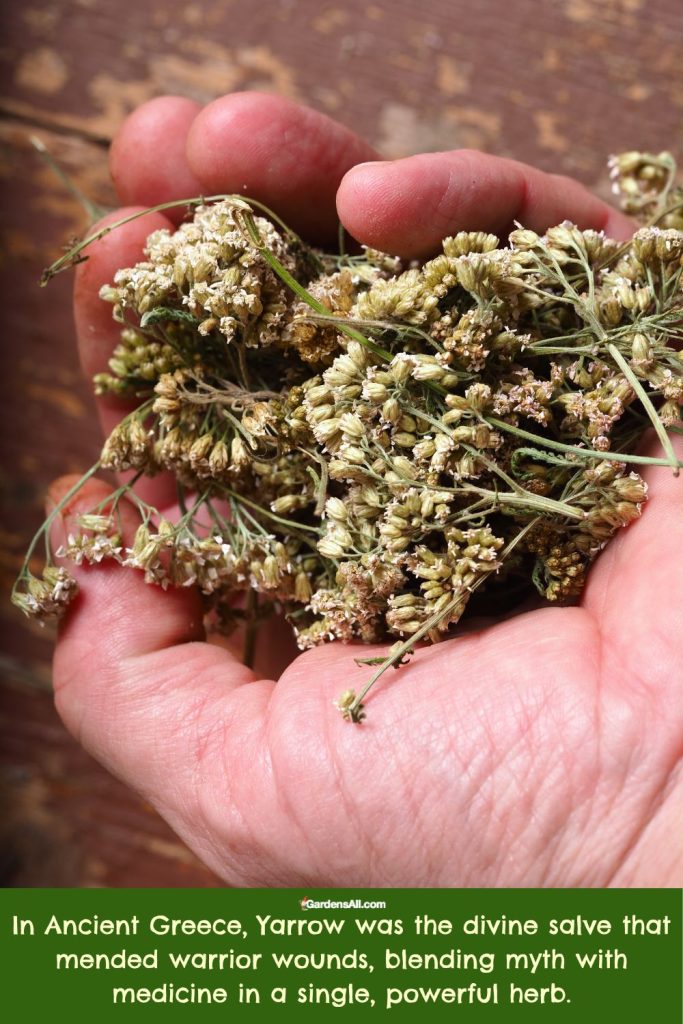
Indigenous North American Tribes Use of Yarrow
And indeed, Indigenous peoples of North America have also used Yarrow for a variety of ailments, including wounds. Traditionally, Yarrow was commonly applied as a poultice to wounds to halt bleeding and promote healing.
Some tribes used yarrow as a pain reliever, while others used it to treat ailments ranging from gastrointestinal issues to respiratory problems, most of which have also been validated through scientific research in this modern era.
Traditional Chinese Medicine Use of Yarrow
In traditional Chinese medicine, Yarrow was employed to harmonize the body and mind and used in teas to help with cold and flu symptoms.
European Folks Medicine Use of Yarrow
European folk medicine also recognized the value of Yarrow. In Scandinavia, it was used in beer brewing before hops became prevalent. In the British Isles, Yarrow was a part of various herbal mixtures used for colds, fevers, and to aid digestion.
The Yarrow Family
The plant commonly referred to as Common Yarrow, Achillea millefolium, belongs to the Asteraceae family. However, the Achillea genus contains several species, many of which are referred to as “Yarrow” in common language and share similar properties.
Here’s the common taxonomic order for Yarrow:
Yarrow Taxonomy
- Kingdom: Plantae
- Clade: Tracheophytes
- Clade: Angiosperms
- Clade: Eudicots
- Clade: Asterids
- Order: Asterales
- Family: Asteraceae
- Genus: Achillea
- Family: Asteraceae
- Order: Asterales
- Clade: Asterids
- Clade: Eudicots
- Clade: Angiosperms
Yarrow Species and Common Names
The most common yarrow in North America is Achillea millefolium, or “Common Yarrow”. Within the Achillea genus, we have different species, including:
- Achillea ageratum (Sweet Yarrow or English Mace): Native to Western and Southern Europe.
- Achillea millefolium (Common Yarrow): This species has a wide distribution, found in the temperate regions of the Northern Hemisphere in Asia, Europe, and North America.
- Achillea ptarmica (Sneezewort, Sneezeweed, or Bastard Pellitory): Predominantly found in Northern and Central Europe, as well as temperate parts of Asia.
- Achillea clavennae (Silvery Yarrow): Native to the Alps and other mountainous regions in Europe.
- Achillea erba-rotta (Mosquito plant): Typically found in the Alpine regions of Europe.
Each of these species shares the same higher taxonomic levels but differs at the species level. They are all commonly referred to as some form of Yarrow due to their similar appearance and medicinal properties.
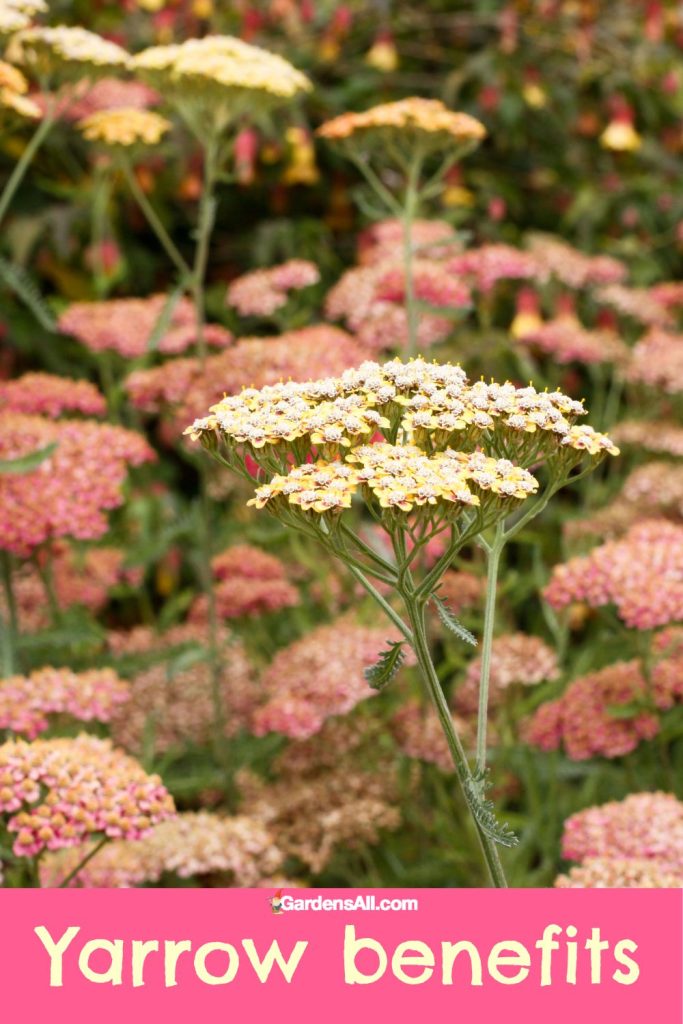
Proven Yarrow Benefits for Health
In the light of modern science, many of Yarrow’s traditional uses have been substantiated with empirical evidence. Here are some examples to give you ideas you can research to help in your natural wellness efforts:
- Antibacterial Properties: Yarrow has been traditionally used for its antibacterial properties, particularly in wound healing. Some research suggests that it can inhibit the growth of certain types of bacteria, but more scientific research is needed to fully confirm these effects.[1]https://www.ncbi.nlm.nih.gov/pmc/articles/PMC3232110/
- Antifungal Benefits: Some studies have suggested that yarrow may possess antifungal properties, making it potentially useful in combating certain fungal infections. As with its antibacterial properties, more research is needed to definitively establish these benefits.[2]https://www.ncbi.nlm.nih.gov/pmc/articles/PMC3232110/
- Anti-Inflammatory Properties: Yarrow’s anti-inflammatory properties have been recognized by modern science. Studies have found that Yarrow could significantly reduce inflammation in acute and chronic inflammatory diseases. Achillea ageratum, AKA sweet yarrow, was found to have to highest anti-inflammatory properties amongst the yarrow tested.[3]https://www.frontiersin.org/articles/10.3389/fphar.2018.00784/full[4]https://www.ncbi.nlm.nih.gov/pmc/articles/PMC8018854/
- Antimicrobial Properties: The term “antimicrobial” is a broad term that encompasses both antibacterial and antifungal properties. Yarrow’s antimicrobial properties have been used traditionally to help prevent infections in wounds and cuts. These benefits are thought to be partially due to compounds like sesquiterpene lactones found in the plant.[5]https://www.ncbi.nlm.nih.gov/pmc/articles/PMC3232110/
- Antioxidant Benefits: Yarrow is rich in flavonoids and other compounds that exhibit antioxidant properties. These antioxidants help neutralize harmful free radicals in the body, contributing to overall health and potentially helping prevent a range of diseases, from cardiovascular disorders to certain types of cancer.[6]https://www.ncbi.nlm.nih.gov/pmc/articles/PMC5590066/[7]https://www.ncbi.nlm.nih.gov/pmc/articles/PMC3232110/
- Antiulcer Benefits: Traditionally, yarrow has been used in the management of ulcers due to its anti-inflammatory, antioxidant, and antimicrobial properties. In addition, yarrow’s ability to stimulate the secretion of digestive enzymes and bile can contribute to the protection and repair of the gastric lining, thus providing potential antiulcer benefits.[8]https://www.ncbi.nlm.nih.gov/pmc/articles/PMC3232110/
- Dandruff Control: The antiseptic and anti-inflammatory properties of Achillea millefolium, particularly when used as an oil or extract in hair care formulations, can help to soothe the scalp, reduce inflammation, and control the overproduction of sebum that can contribute to dandruff.[9]https://www.ncbi.nlm.nih.gov/pmc/articles/PMC8018854/
- Diabetes Management: Achillea millefolium’s potential hypoglycemic effects might also extend to the management of diabetes. The herb may aid in blood sugar regulation, possibly assisting in the overall management of diabetes.[10]https://www.ncbi.nlm.nih.gov/pmc/articles/PMC3232110/
- Digestive Health: Yarrow is a powerful digestive aid. It stimulates the secretion of digestive enzymes and bile, promoting digestion and aiding in nutrient absorption. It has been used to treat a range of digestive problems, including indigestion, cramps, bloating and intestinal spasms, such as IBS.[11]https://www.ncbi.nlm.nih.gov/pmc/articles/PMC3847392/
- Hemostatic: Yarrow can help stop bleeding, both externally and internally, hence its historical use in treating battlefield wounds. The leaves were traditionally inserted in the nostrils to stop nosebleeds. (See wound healing below).[12]https://www.ncbi.nlm.nih.gov/pmc/articles/PMC3232110/
- Hypoglycemia Management: Preliminary studies suggest that Achillea millefolium may have hypoglycemic (blood sugar-lowering) effects, potentially making it a helpful supplement in managing hypoglycemia.[13]https://www.ncbi.nlm.nih.gov/pmc/articles/PMC3232110/
- Menstrual Relief / Emmenagogue: Yarrow is often used to alleviate menstrual discomfort. It has antispasmodic properties that can help relieve cramps, and it is also used to regulate menstrual cycles and as an emmenagogue, for inducing menstrual flow.[14]https://www.ncbi.nlm.nih.gov/pmc/articles/PMC3232110/
- Respiratory Health: Yarrow has been found to be beneficial for respiratory health, especially when used in herbal teas. It can help to soothe sore throats, reduce fever, and clear congestion in the lungs.
- Wound Healing: Consistent with its historical use, several studies have shown Yarrow’s ability in wound healing. Studies have shown that Yarrow can accelerate the wound healing process, thanks to its anti-inflammatory, antimicrobial and astringent properties.[15]https://www.frontiersin.org/articles/10.3389/fphar.2018.00784/full[16]https://www.ncbi.nlm.nih.gov/pmc/articles/PMC3232110/
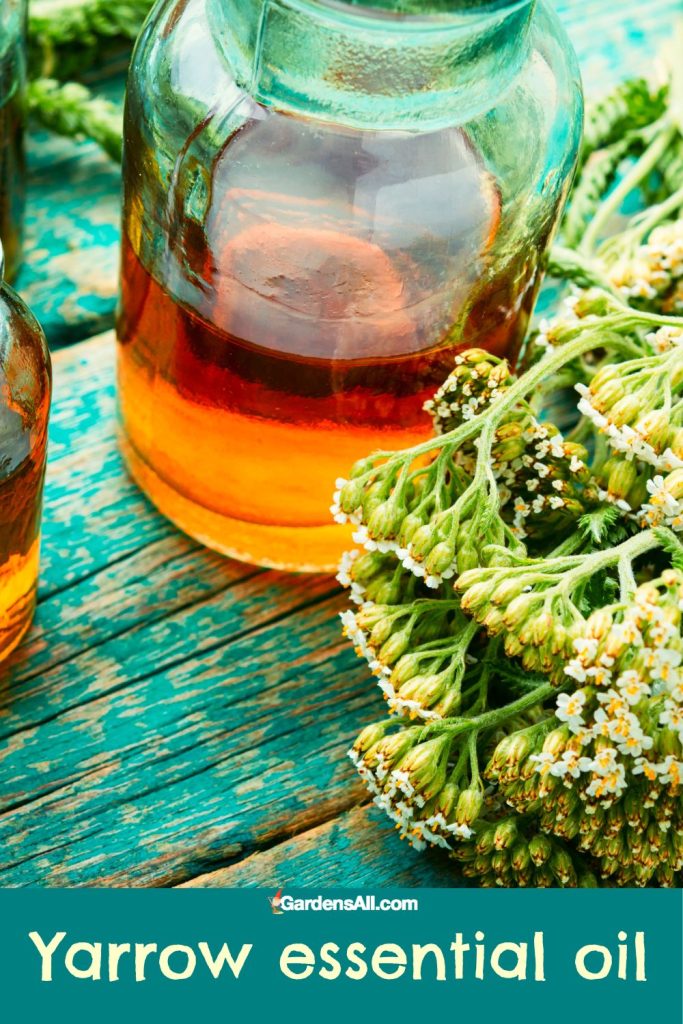
Other — Non-Medicinal — Yarrow Benefits and Uses
- Conservation Practices:
- Erosion control: Yarrow has a robust root system that can help stabilize soil, making it useful in erosion control efforts.
- Remediation: Yarrow is also known for its ability to improve soil quality by accumulating and redistributing nutrients, playing a role in remediation practices.
- Cosmetic Uses:
- Ingredient in skincare products: As previously detailed, yarrow extracts are used in various cosmetic formulations for their potential benefits to skin health.[17]https://www.ncbi.nlm.nih.gov/pmc/articles/PMC8018854/
- Natural perfume: AKA “masking”, the essential oil extracted from yarrow is used in perfumery due to its unique, pleasant scent.[18]https://www.ncbi.nlm.nih.gov/pmc/articles/PMC8018854/
- Foraging:
- Culinary uses: The young leaves of yarrow can be eaten raw or cooked. They have a slightly bitter taste and are often used in salads or as a seasoning.
- Brewing: Yarrow has historically been used in the brewing of beer, before the widespread use of hops.
When foraging, it’s important to remember to forage responsibly, only taking what you need so as to leave plenty for the wildlife and ecosystem.
- Mosquito Repellent: Laboratory tests showed that yarrow extract exhibited a similar repellency as DEET![19]https://pubmed.ncbi.nlm.nih.gov/23195905/[20]https://www.nrcs.usda.gov/plantmaterials/mtpmcpg13974.pdf
See also, Catnip benefits, including for mosquito repellent. - Ornamental Uses:
- Garden plant: With its compact size, feathery leaves, and clusters of flowers, yarrow is a popular choice for garden borders, rock gardens, or wildflower meadows.
- Dried flowers: Yarrow flowers dry well and are often used in floral arrangements.
- Ingredient in skincare products: As previously detailed, yarrow extracts are used in various cosmetic formulations for their potential benefits to skin health.[21]https://www.ncbi.nlm.nih.gov/pmc/articles/PMC8018854/
- Natural perfume: AKA “masking”, the essential oil extracted from yarrow is used in perfumery due to its unique, pleasant scent.[22]https://www.ncbi.nlm.nih.gov/pmc/articles/PMC8018854/
- Wildlife Benefits:
- Pollinator attractant: Yarrow is a known attractant for many types of beneficial insects, including bees and butterflies, contributing to biodiversity and healthy ecosystems.
- Food source: Various species of wildlife, like deer and rabbits, eat yarrow.
- Other Uses:
- Natural dye: The yellow yarrow flowers can be used to produce a yellow dye.
- Cultural significance: Yarrow has been used historically in various cultural practices, including divination rituals.
Common yarrow ingredients are found in present-day pharmaceuticals and are used by herbalists.
USDA Natural Resources Conservation Service[23]https://www.nrcs.usda.gov/plantmaterials/mtpmcpg13974.pdf
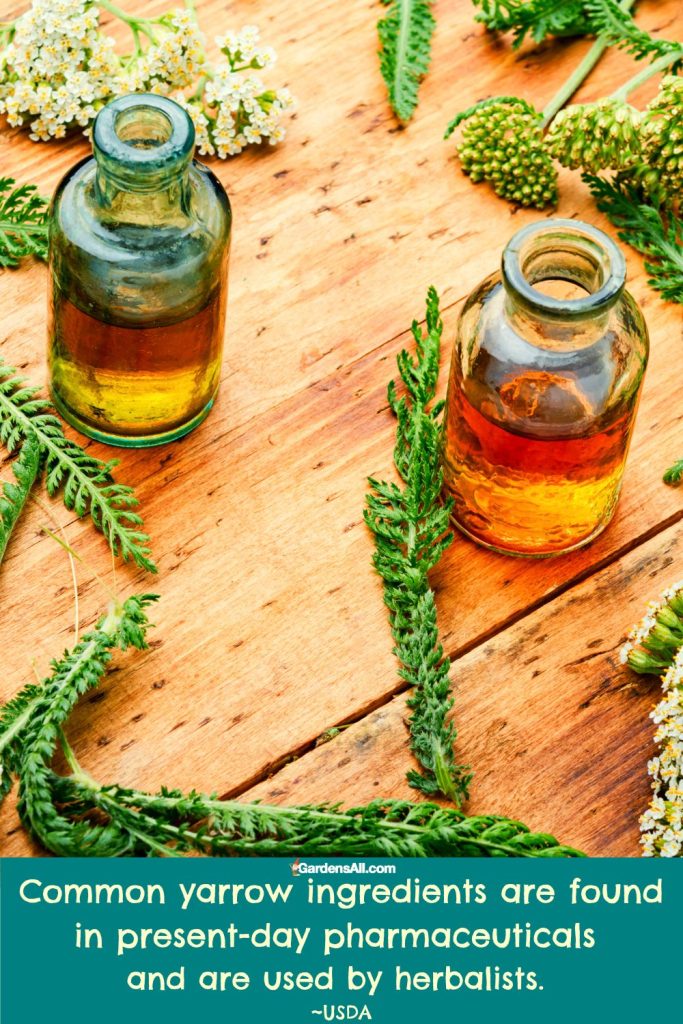
Yarrow Uses and Forms – Tea, Tincture, Topical & Capsules
Yarrow can be used in various forms. It’s often brewed as a tea, used in topical applications like creams and salves, or taken as a tincture or capsule.
Here’s a summary of Yarrow’s various forms of usage along with its potential health benefits, followed by a chart of similar information:
- Yarrow Tea (Made from Leaves and Flowers):
- Respiratory health: Yarrow tea, brewed from the leaves and flowers, can help soothe sore throats, reduce fever, and alleviate symptoms of the common cold or flu.
- Digestive aid: The same tea can stimulate the secretion of digestive enzymes and bile, promoting digestion and nutrient absorption.
- Anti-dandruff, cleansing, masking, refreshing, skin conditioning, soothing tonic
- Yarrow Tincture or Extract (Made from the Whole Plant):
- Digestive problems: A tincture made from the whole yarrow plant can be used to relieve symptoms of indigestion, bloating, and cramps.
- Menstrual relief: The antispasmodic properties of this tincture can also help alleviate menstrual cramps.
- Skin – see topical applications next and also the chart below
- Topical Applications of Yarrow(Made from Leaves and Flowers):
- Wound healing: When applied topically, creams or salves made from yarrow leaves and flowers can aid in wound healing due to their anti-inflammatory and antimicrobial properties.
- Skin care: Beneficial in managing skin conditions such as eczema and mild acne. Studies also indicate yarrow effectiveness for cosmetics, with skin calming and rejuvenating properties.
- Yarrow Capsules (Made from Dried Leaves and Flowers):
- Anti-inflammatory benefits: Capsules made from dried yarrow leaves and flowers can help reduce inflammation in acute and chronic inflammatory diseases.
- Digestive health: Taken regularly, these capsules may also aid digestion and nutrient absorption.
The medicinal properties of Achillea millefolium are globally recognized and the plant is included in the national Pharmacopoeias of countries such as Germany, Czech Republic, France and Switzerland.
Study: Saeidnia S, Gohari A, Mokhber-Dezfuli N, Kiuchi F. A review on phytochemistry and medicinal properties of the genus Achillea. Daru. 2011;19(3):173-86. PMID: 22615655; PMCID: PMC3232110.[24]https://www.ncbi.nlm.nih.gov/pmc/articles/PMC3232110/
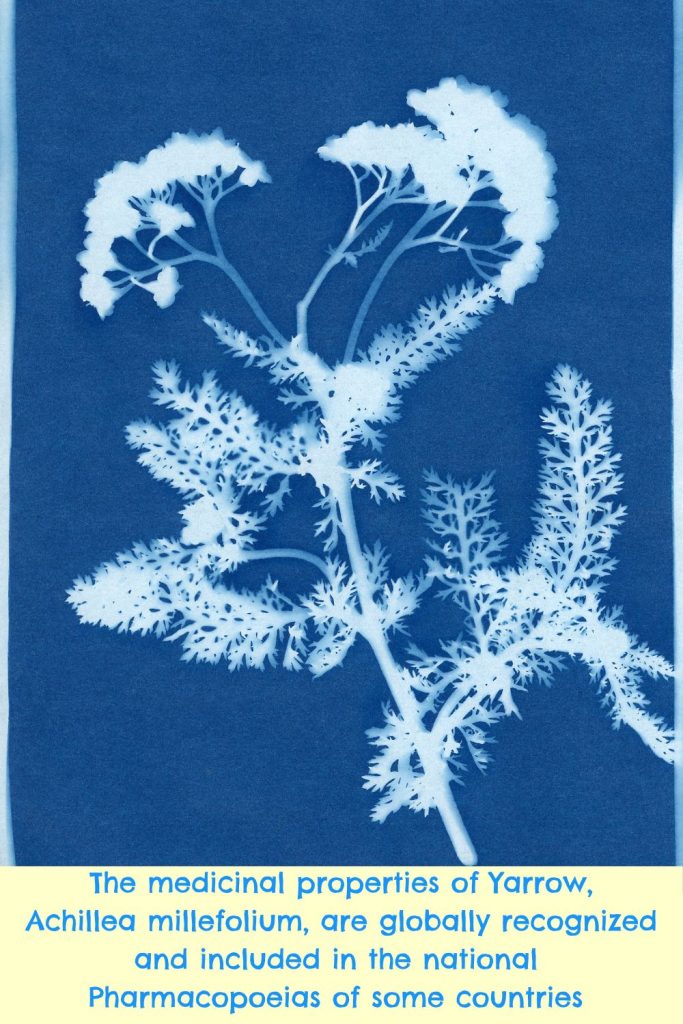
Yarrow Uses, Forms and Benefits
Here’s a chart with a comprehensive overview of the various uses of different parts of the Yarrow plant, both in health applications and cosmetic formulations, and most of which ethnobotanical uses have also been proven scientifically.
| Yarrow Preparation | Part of Yarrow Used | Function in Health Applications |
|---|---|---|
| Yarrow Tea | Leaves and Flowers | Respiratory health aid, Digestive aid |
| Yarrow Tincture | Whole Plant (typically leaves, flowers, and stems) | Digestive problems relief, Menstrual cramps relief |
| Yarrow Topical Applications (Creams, Salves) | Leaves and Flowers | Wound healing, Skin care |
| Yarrow Capsules | Dried Leaves and Flowers | Anti-inflammatory benefits, Digestive health aid |
| Achillea millefolium extract | Extract from the leaves and flowers | Antidandruff, cleansing, masking, refreshing, skin conditioning, soothing, tonic |
| Achillea millefolium flower extract | Extract from the flowers | Antioxidant, humectant |
| Achillea millefolium flower water | Aqueous solution from the steam distillation obtained from the flowers | Masking |
| Achillea millefolium flower/leaf/stem juice | Juice pressed from the flowers, leaves, and stems | Skin conditioning |
| Achillea millefolium oil, Yarrow oil | Essential oil obtained from the flowering herb | Antidandruff, cleansing, masking, perfuming, refreshing, soothing, tonic |
As always, it’s important to remember that individual responses can vary and always consult a healthcare professional before beginning any new health regimen.
Yarrow Healing Properties and Nutrients
Yarrow is rich in a variety of compounds and nutrients that contribute to its healing properties. Here’s a list of some of its beneficial components:
- Polyphenolics: Beneficial plant compounds with antioxidant properties.
- Flavonoids: These are potent antioxidants that protect the body’s cells from damage.
- Tannins: These compounds have astringent properties and can help with wound healing.
- Alkaloids: They are naturally occurring compounds, some of which can have medicinal properties.
- Cineole: A compound that can have expectorant and anti-inflammatory effects, and is often found in essential oils.
- Chamazulene: This compound gives yarrow its anti-inflammatory properties. It’s especially prevalent in the essential oil of yarrow.
- Pinene: This is a monoterpene with anti-inflammatory and antiseptic properties.
- Sesquiterpene lactones: These compounds are known for their anti-inflammatory and antimicrobial effects.
- Vitamins and Minerals: Yarrow is also a good source of several nutrients, including Vitamin C and K, calcium, and potassium.
Each of these components plays a role in the plant’s overall health benefits, contributing to its long history of use in traditional medicine.
Precautions in Using Yarrow
While yarrow is generally safe for most people, there are certain precautions one must take:
- Pregnant and breastfeeding women should avoid Yarrow, as it can potentially stimulate the uterus.
- Those with allergies to plants in the Asteraceae family should also be cautious, as Yarrow belongs to this family.
Yarrow, like many other plants used in traditional medicine, bridges the gap between ancient wisdom and modern science. Its extensive use across cultures, combined with growing scientific evidence, attests to its remarkable medicinal qualities. As researchers continue to uncover the full potential of this powerful plant, Yarrow will likely continue to be a staple in natural healing and therapeutic remedies.
Mystical Yarrow
Whispering to the ancients, Yarrow was the key to the fairy realm, a mystical herb enchanting us with promises of protection and visions of unseen worlds.

References
Please note that this article does not replace professional medical advice, and it’s always advisable to consult your trusted healthcare professional before using anything for medicinal purposes. This is particularly important if you are pregnant, breastfeeding, or have any medical conditions.
Citations on Some of the Scientific Study Sources:
- Saeidnia, S., Gohari, A., Mokhber-Dezfuli, N., & Kiuchi, F. (2011). “A review on phytochemistry and medicinal properties of the genus Achillea”. Daru: Journal of Faculty of Pharmacy, Tehran University of Medical Sciences.[25]https://www.ncbi.nlm.nih.gov/pmc/articles/PMC3232110/
- Carvalho AR Jr., Diniz RM, Suarez MAM, Figueiredo CSSS, Zagmignan A, Grisotto MAG, Fernandes ES and da Silva LCN (2018) Use of Some Asteraceae Plants for the Treatment of Wounds: From Ethnopharmacological Studies to Scientific Evidences. Front. Pharmacol. 9:784. doi: 10.3389/fphar.2018.00784[26]https://www.frontiersin.org/articles/10.3389/fphar.2018.00784/full
I’m LeAura Alderson, a garden, herb and plant enthusiast with a passion for discovering the many edible and medicinal benefits of the plants all around us, including the weeds! I’m a writer, editor and media publisher for our family of websites.
While I was certified in fitness and life coaching, I am NOT a health practitioner. However, I’m a lifelong health enthusiast, with a keen interest in healthy, organic foods and making home remedies and the content we share is from our own experience and usage as well as that extracted from scientific research so that you can explore further on your own.
Always seek the advice and guidance of your health practitioners first and foremost.
As a family we’re steadily expanding our gardening, experimentation and knowledge around all things gardening, edible landscaping, fresh organic foods and self sustainability with farming in our future. I also own and manage iCreateDaily.com, a site all about transformation through creation, and the power of positivity, optimism and mindset.
References

